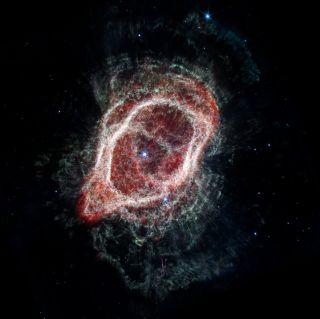The glorious, billowing Southern Ring Nebula is the cocoon of a dying star — and it has a secret. Scientists have found this nebula to exhibit a double-ring structure that evidences not one, but possibly three stars at its heart.
The Southern Ring Nebula, also designated NGC 3132, is a planetary nebula located about 2,000 light-years away in the constellation of Vela, the Sails. The name “planetary nebula” is a misnomer — such nebulas have nothing to do with planets. Instead, they are the final exhalations of dying, sun-like stars, which transform inside the nebulous chrysalis until finally blossoming into a white dwarf. A nebula is formed from the dying star’s outer envelope, which is puffed off into space following the star’s red giant phase.
The Southern Ring Nebula was imaged in December 2022 by the James Webb Space Telescope (JWST), which revealed molecular hydrogen gas forming the nebula’s “exoskeleton.” This refers to warm gas radiating with a temperature equal to about 1,000 kelvin (1,340 degrees Fahrenheit, or 726 degrees Celsius) as it gets illuminated and heated by ultraviolet light coming from the white dwarf itself. That exoskeleton, however, only represents a small fraction of the molecular gas in the nebula.
Related: Horsehead Nebula rears its head in gorgeous new James Webb Space Telescope images (video)

Sponsor A War Children Today:
SaveWorldChildren.org
A team led by Joel Kastner of the Rochester Institute of Technology went hunting for more of the nebula’s molecular gas, specifically searching for carbon monoxide gas using the Submillimeter Array (SMA), which is a group of eight radio telescopes on an inactive volcano named Mauna Kea in Hawaii. Carbon monoxide is mixed in with hydrogen and other molecular gases inside the nebula, so observing the carbon monoxide content is actually a proxy for observing all those other molecules that are not as easy to detect. Sure enough, the SMA was able to measure both the distribution and velocities of the carbon monoxide molecules, showing which parts are moving towards us and which are moving away from us.
“JWST showed us the molecules of hydrogen and how they stack up in the sky, while the Submillimeter Array shows us the carbon monoxide that is colder that you can’t see in the JWST image,” said Kastner in a press statement.
As the Southern Ring’s name suggests, it is primarily shaped (from our point of view) as a ring. The SMA observations showed that this ring is expanding, which is to be expected as the nebula slowly grows before eventually dispersing. However, the data also allowed Kastner’s team to create a three-dimensional map of the nebula’s molecular exoskeleton. This offered up a surprise. Not only were the researchers able to show that what we see as a ring is merely a lobe in a bi-polar nebula seen end-on, but they also found a second ring perpendicular to the first.
“When we started to turn the whole nebula around in 3D, we immediately saw it was really a ring, and then we were amazed to see there was another ring,” said Kastner.
The whole bizarre arrangement paints a fascinating tail of not one, not even two, but quite possibly three stars at the heart of the nebula. Only one of these stars, the most massive of the three, will have reached the end of its life — but the stellar trio, if all three really exist, are likely either too close to one another or too faint to be separately resolved, even by the JWST.
There’s growing evidence that some planetary nebulas, at least those that sport complex structures, are formed from the interference of a companion star to the central dying star. For the Southern Ring, Kastner’s team posits that a triple system formed of a close binary is orbited by a more distant, third star within an orbital radius of 60 astronomical units of the binary (one astronomical unit, AU, is the distance between Earth and the sun, and in our solar system 60 AU would be out at the far edge of the Kuiper Belt).
The two lobes of the Southern Ring have a narrow, or “pinched,” waistline, like an hourglass, which is a common feature of planetary nebulas emanating from a binary star system in which one of the stars is reaching the end of its life. The binary companion is able to corral the material shed by the dying star so that it escapes along a polar, rather than equatorial, direction, forming the two lobes. The JWST’s mid-infrared observations support this hypothesis, having found an excess of infrared light coming from the central star system, which is a classic signature of a dusty disk formed from interactions between the red giant and a close binary companion.
So, that explains the first ring. The origin of the second ring, the team says, is less certain.
Though the Southern Ring appears bi-lobed, some material must have been emitted as a roughly spherical or ellipsoidal envelope of material cast off by the red giant, a rapid mass-loss event that perhaps represented its final exhalation of material to leave behind the white dwarf. The binary star system produces a series of fast, narrow jets, but if a third star is present, then the extra star’s gravity would act on the inner binary, causing the direction of the jets to “wobble,” like a spinning top. Those precessing jets would have carved out a circular hollow in the ellipsoidal component of the nebula, thereby creating the second ring.
Kastner emphasizes that this explanation is still speculative, but the nebula’s central ionized cavity does bear the evidence of such jets in its structure.
Other ring-shaped planetary nebulas, such as the Helix Nebula (NGC 7293 in Aquarius), have also been shown to have bi-lobed structures by which we are looking “down” the end of one lobe. The discovery of the second ring in the Southern Ring Nebula — or should that now be Southern Rings, plural? — is prompting astronomers to revisit some of those other well-known ring nebulas to see if they have missed second rings in them, too.
Planetary nebulas don’t just signify stellar death. They also hold the promise of new life — literally, in a sense.
“Where does the carbon and the oxygen and the nitrogen in the universe come from?” wonders Kastner. “We’re seeing it generated in the sun-like stars that are dying, like the star that’s just died and created the Southern Ring.”
Related Stories:
As an expanding planetary nebula disperses into interstellar space, it spreads those molecules across the cosmos, where they wind up in giant molecular clouds that form the next generation of stars and planets.
“A lot of that molecular gas would wind up in planetary atmospheres and atmospheres can enable life,” says Kastner. Indeed, all the elements on Earth heavier than hydrogen and helium originated inside stars and were then ejected into space when those stars died.
We are literally star-stuff, as many experts like to say.
So, when we marvel at the beauty of stellar death in nebulas such as the Southern Ring, we can also imagine it as a stellar phoenix to one day rise from the ashes and begin the cycle of star-birth and death all over again. To quote Battlestar Galactica, all this has happened before, and all of this will happen again.
The findings were published on April 2 in The Astrophysical Journal.
This post was originally published on 3rd party site mentioned in the title this site










